Visual Tutorial
Debits and Credits
Debits and credits are similar to the words used in Italy more than 500 years ago when recording business transactions. Today, we continue to use these terms. Debit is used to indicate left. Credit is used to indicate right.
Debit means left or left side.
Credit means right or right side.
Bookkeepers and accountants store transaction amounts in a record referred to as an account. Accountants will likely use hundreds of accounts for each business or other organization. A listing of the accounts used in a business is known as a chart of accounts. The chart of accounts can be expanded as the need arises. Accounts that contain amounts will be included in the company’s general ledger. Hence, the accounts are often referred to as general ledger accounts.
Accounts are used to sort, store, and retrieve amounts.
A chart of accounts is a listing of the accounts available for use.
The accounts with amounts are found in the general ledger.
The accounts used in a business are classified or categorized as follows:
Current assets: cash, accounts receivable, inventory, prepaid expenses
Noncurrent (or long-term) assets: land, buildings, equipment, vehicles
Current liabilities: loans payable, accounts payable, customer deposits
Noncurrent (or long-term) liabilities: bonds payable, loans payable
Owner’s (or stockholders’) equity: owner’s capital, draws
Revenues from operations: sales, fees earned
Expenses from operations: cost of goods sold, salaries, advertising
Other revenues and gains: investment income, gain on sale of assets
Other expenses and losses: interest expense, loss on sale of assets
The asset, liability, and owner’s equity account balances are reported on the financial statement known as the balance sheet or the statement of financial position. The outline of the balance sheet is the accounting equation: assets = liabilities + owner’s equity. Both the balance sheet and the accounting equation must be in balance.
The balance sheet and accounting equation must always be in balance:
Assets = Liabilities + Owner’s Equity
The revenues, expenses, gains and losses are reported on the income statement (or statement of earnings or profit and loss statement). The combination (or net) of revenues, expenses, gains and losses is the company’s net income.
The income statement reports the following amounts:
Revenues – Expenses + Gains – Losses = Net Income
The net income reported on the income statement causes the owner’s equity on the balance sheet to change. That also means that revenues and gains will cause an increase in owner’s equity, while expenses and losses will cause a decrease in owner’s equity.
Revenues, gains, and net income cause the owner’s equity to increase.
Expenses, losses, and a net loss cause the owner’s equity to decrease.
The connection between the income statement and the balance sheet is an important reason why the balance sheet and the accounting equation will remain in balance.
Another reason why the accounting equation and the balance sheet will remain in balance is the procedure known as double-entry. Double-entry requires that every transaction will involve two (or more) accounts.
Double-entry requires that two accounts or more are involved in every transaction.
Here’s an example. If Amy Loy invests $5,000 of her personal cash in her new sole proprietorship Loy Company, this transaction will involve the business asset Cash and the owner’s equity account Amy Loy, Capital.

Double-entry is also associated with the debits and credits documented more than 500 years ago. As a result, there are actually two requirements:
- Two accounts are involved, and
- One account must have the amount entered on the left or debit side, and one account must have the amount entered on the right or credit side.
The amount of the debits = the amount of the credits.
The format of accounts will vary with each company’s software. Here’s one example:
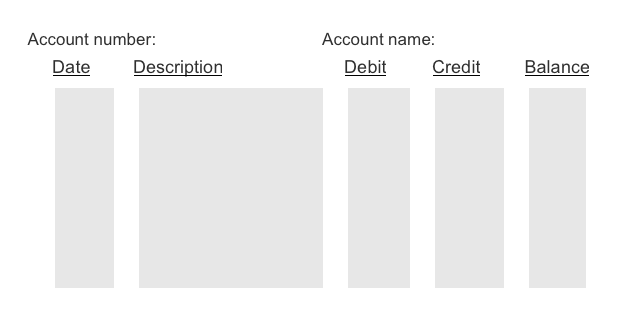
For learning our debits and credits, we will use the format known as a T-account:
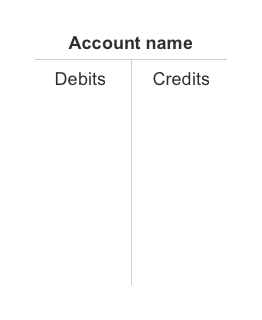
Since each transaction will involve a minimum of two accounts, we will present two T-accounts when discussing each transaction.
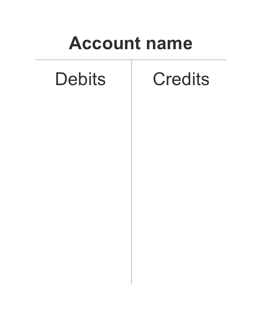
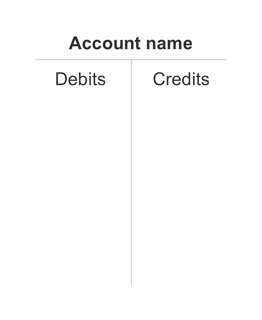
Typically, the asset account Cash has a large volume of activity. If a business transaction increases a company’s cash, the Cash account is debited. In other words, when cash is received, a debit is entered in the account Cash. When a company pays cash, a credit is entered in the Cash account.
When cash is received, debit the account Cash.
When cash is paid, credit the account Cash.
Here’s a picture of the T-account for Cash:
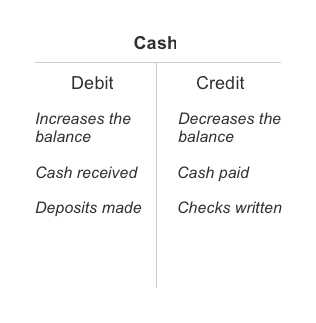
The procedure to change the balance in any asset account is the same as the Cash account: debit an asset account to increase its balance, and credit an asset account to decrease its balance. We also expect the balance in an asset account to be a debit balance. In other words, in an asset’s T-account, we expect to see the balance on the left side.
Debit an asset account to increase its balance.
Credit an asset account to decrease its balance.
Asset accounts usually have a debit (or left-side) balance.
Another way to remember that asset accounts usually have a debit balance is to think of the accounting equation:
Assets = Liabilities + Owner’s Equity
Assets appear on the left side of the accounting equation and we expect that the balances in the asset accounts will also appear on the left side of the asset accounts.
Transaction #1.
Let’s revisit our earlier example where Amy Loy invested $5,000 of her personal cash in her new sole proprietorship, Loy Company. Since the company is receiving cash of $5,000, the asset Cash will have to be debited, and a second account will have to be credited for $5,000.
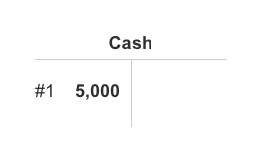
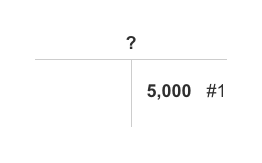
The next step is to identify the name of the account that is to be credited. In this example, the account to be credited is Amy Loy, Capital:
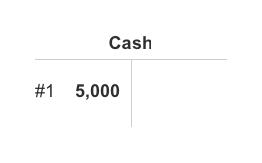
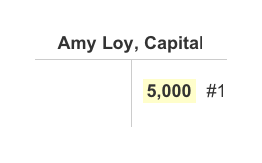
From these T-accounts we see that the owner’s equity account Amy Loy, Capital was credited in order to increase its balance from zero to $5,000. This is also consistent with the accounting equation which shows owner’s equity on the right side:
Assets = Liabilities + Owner’s Equity
Transaction #2.
Let’s assume that Loy Company also borrows $2,000 and the amount is deposited into its checking account. The two accounts involved are Cash and Loans Payable. Loans Payable is a liability account and is increased with a credit entry as shown here:
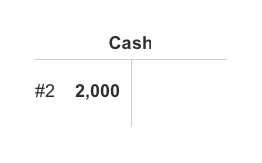
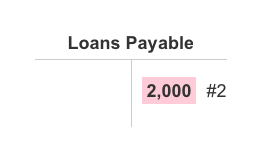
Notice that Loans Payable has its balance on the right side, or credit side, similar to the position of liabilities in the accounting equation.
Assets = Liabilities + Owner’s Equity
In addition to every transaction having debits equal to credits, the balances in the general ledger accounts must have the total of the debit balances equal to the total of the credit balances. A trial balance is a listing of all of the account balances in the general ledger and the total of each of the columns of amounts. The column totals must be equal.
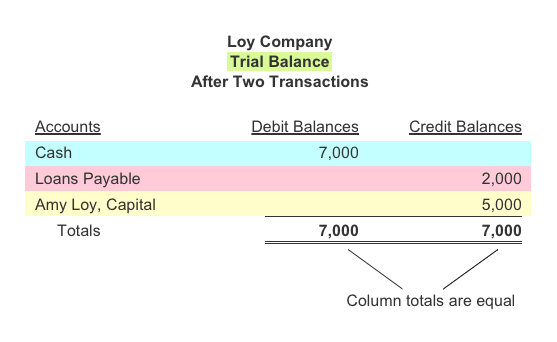
Transaction #3.
Let’s assume that the third transaction involves paying $800 for a computer. As we know, when cash is paid (or a check is written) the Cash account is credited. The second account will need to have a debit of $800. In this example, the second account is the asset Office Equipment. Here’s the entry in T-account format.
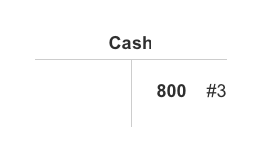
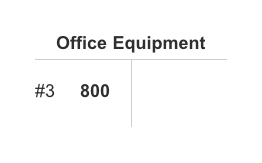
If we look into the Cash account, we will see the following activity and the resulting debit balance of $6,200:
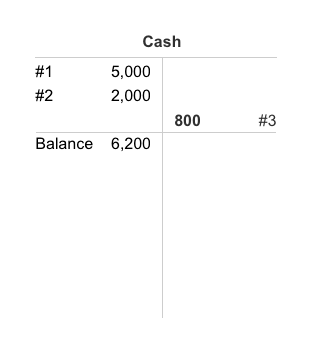
The trial balance after the third transaction will report the following amounts:
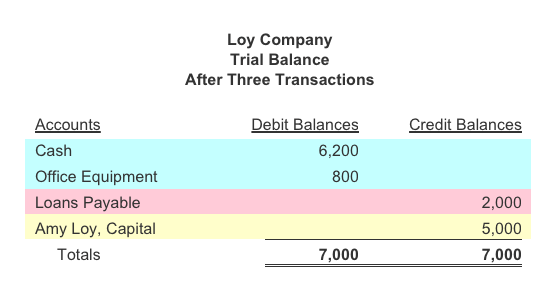
The balance sheet and the accounting equation for Loy Company after the third transaction will report the following totals:

Transaction #4.
Let’s assume that Loy Company is going to repay $500 of its loan. In other words, Loy will reduce its asset Cash and will reduce its liability Loans Payable. Recall that Cash and other assets will be reduced with a credit. To reduce the credit balance in a liability account such as Loans Payable, a debit must be entered into the liability account. In T-account format, here is Loy Company’s entry to repay $500 of its loan:
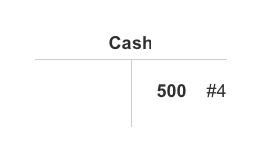
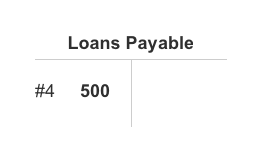
Here are the two accounts showing all of the activity and their balances after the $500 payment is recorded:
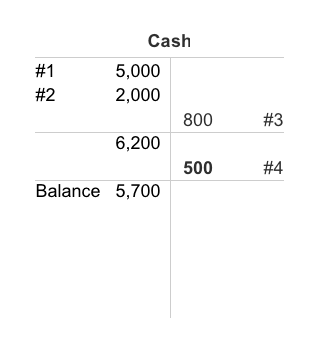
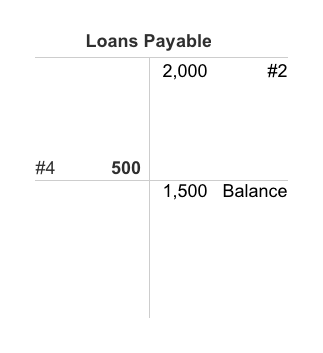
The trial balance after the fourth transaction will report the following amounts:
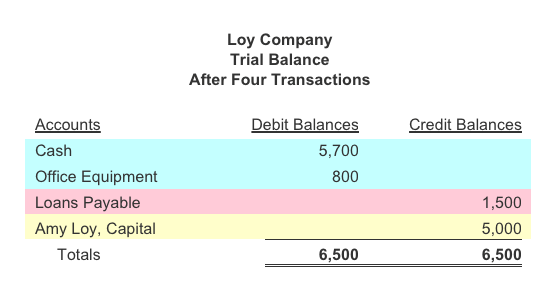
The balance sheet and the accounting equation for Loy Company after the fourth transaction will report the following:

Revenues
Revenues are amounts earned when a company delivers products or services to customers. Often these revenues are referred to as sales or sales revenues. Businesses that provide services might refer to their revenue as service revenues.
Revenues are recorded in temporary revenue accounts and the amounts will be reported on the income statement. The revenue accounts are temporary because the amounts are stored there only temporarily. Later they will be transferred to the owner’s equity account. This means that revenues will be reported on the income statement and will also increase owner’s equity and assets. For example, if a sole proprietorship performs a service for $100, the accounting equation will change as follows:

Under the accrual method of accounting, revenues are reported on the income statement in the period in which they are earned, and this is usually the period in which they are delivered. For example, if Loy Company receives an order on May 29 for goods or services that will be delivered on June 4 and the customer is expected to pay on July 5, the sale is reported as of June 4. (Under the accrual method of accounting, the receipt of cash is not a requirement for reporting revenues.)
Transaction #5.
On June 4, Loy Company delivers services at the agreed-upon amount of $100 and the customer pays cash for the services. The two accounts involved are the balance sheet asset account Cash and the income statement account Service Revenues. Since the asset Cash is increasing, we need to debit Cash for $100. This means that the other account, Service Revenues, will need to be credited. A credit to Service Revenues is logical because revenues cause the owner’s equity to increase. (Recall that owner’s equity is on the right side, or credit side, of the accounting equation.)
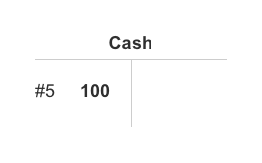
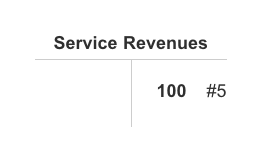
The trial balance after the fifth transaction will report the following amounts:
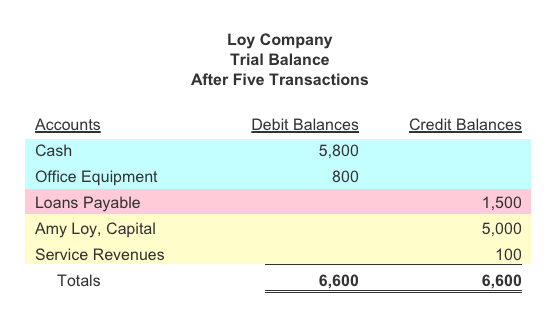
Notice that the temporary account Service Revenues is shown below the owner’s equity account Amy Loy, Capital. The Service Revenues account is used to keep a separate record of the revenues for the year. Once the year is completed, the amounts in the revenue accounts will be transferred to Amy Loy, Capital.
In terms of the accounting equation and the balance sheet, the amounts after five transactions are:

Transaction #6.
On June 10, Loy Company delivers $700 of services and allows the customer to pay in 30 days. The two accounts involved are the asset account Accounts Receivable and the temporary income statement account Service Revenues. Here is the transaction to be recorded on June 10:
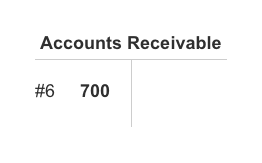
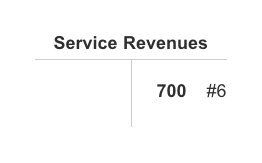
The effect of the June 10 transaction on the balance sheet and the accounting equation is:

The trial balance after the sixth transaction will report the following amounts:
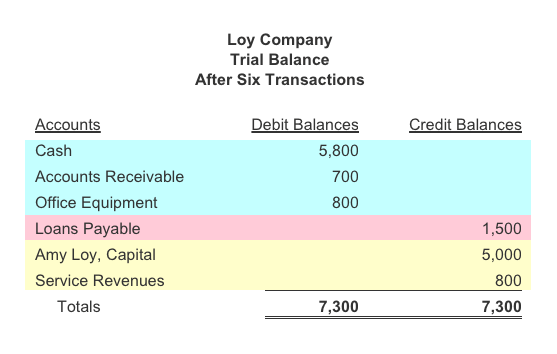
In terms of the accounting equation and the balance sheet, the amounts after six transactions are:

Expenses
Expenses are costs that a company has used up in order to earn the revenues. An example is the cost of goods sold or commissions expense. If this matching is not obvious, costs are reported on the income statement in the period in which they expire. An example of this is depreciation on office equipment. Lastly, if we cannot measure any future value, costs are reported in the period in which they occur. Examples are salaries of office employees and advertising.
Expenses are recorded in temporary accounts and those amounts will be reported on the income statement. The expense accounts are temporary because their amounts will be transferred to the owner’s equity account after the year ends. This means that expenses will be reported not only on the income statement but will decrease owner’s equity and will either decrease assets or will increase liabilities, which are reported on the balance sheet.
Expenses are debited, because they cause a decrease in owner’s equity, which is expected to have a credit balance. (Recall that owner’s equity is on the right or credit side of the accounting equation.) If we assume that a $900 expense occurs and the company has 20 days in which to pay the supplier, the balance sheet and accounting equation are affected as follows:

The liabilities increase because the company will have an obligation to pay the supplier or vendor.
Transaction #7.
On June 25 and 26, Loy Company runs ads on the local radio station and will have to pay by July 10. The cost of the ads is $900. Since accountants cannot measure the future benefit of ads, the entire $900 must be expensed in June. Here is the accounting entry in T-account format.
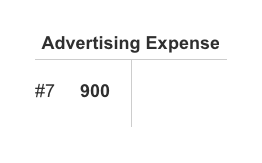
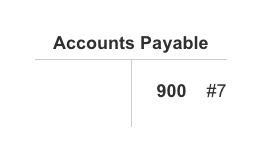
Under the accrual method of accounting, the expense is reported when the expense and liability occur (not when the cash payment is made).
After Transaction #7, the trial balance will report the following amounts:
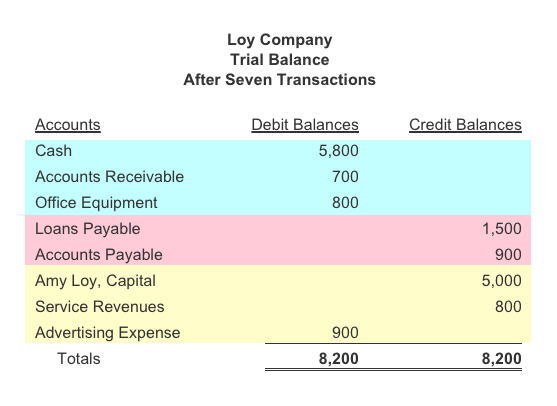
In terms of the accounting equation and the balance sheet, the amounts after seven transactions are:

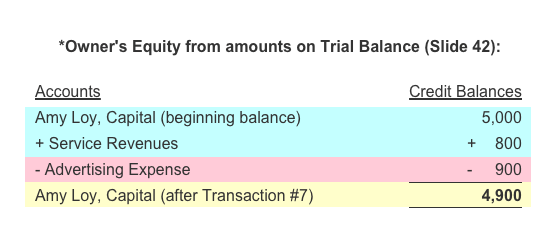
Collection of Accounts Receivable
When a company collects some of its accounts receivable, there is both an increase and a decrease in assets. Under the accrual method of accounting, there is no new revenue being earned. In this example there will be no change in the total amount of assets, no change in owner’s equity, and no effect on the income statement. We will see this illustrated in the following transaction.
Transaction #8.
On July 9, Loy Company receives $700 from its customer who had received services on credit on June 10. (See Transaction #6.) The July 9 transaction in T-account format is:
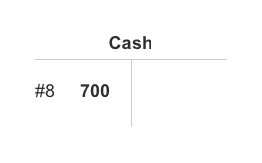
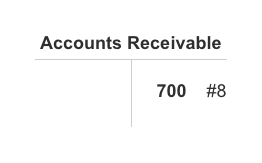
Under the accrual method of accounting, the collection of accounts receivable does not affect a revenue account. In other words, the receipt of cash is different from earning revenues.
In terms of the accounting equation and balance sheet, the transaction has the following effect:
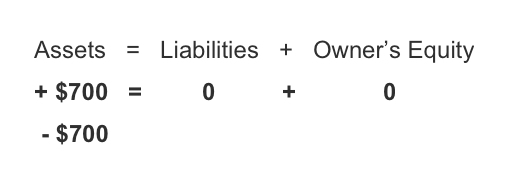
The above equation reflects that one asset Cash increased by $700, while another asset Accounts Receivable decreased by $700.
After Transaction #8, the trial balance will report the following amounts:
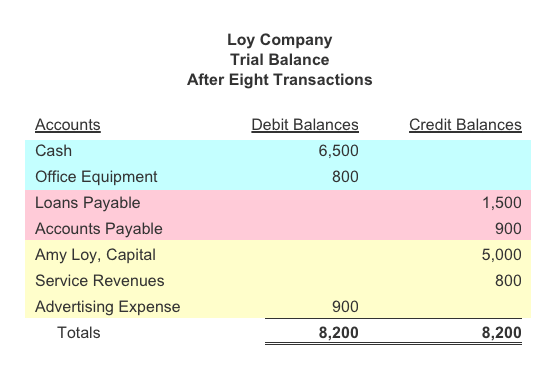
In terms of the accounting equation and the balance sheet, the totals after eight transactions are the same as they were after seven transactions:

Payment of Accounts Payable
When a company pays some of its accounts payable, there is a decrease in assets and a decrease in liabilities. Under the accrual method of accounting, there is no new expense incurred and therefore no effect on net income or owner’s equity. In other words, the payment of cash does not mean there is an expense. An expenditure is not necessarily an expense.
Transaction #9.
On July 10, Loy Company pays $900 for the ads described in Transaction #7. The July 10 payment in T-account format is:
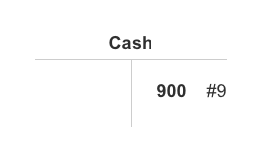
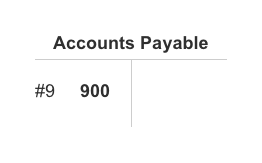
In terms of the accounting equation and balance sheet, the transaction has the following effect:

After Transaction #9, the trial balance will report the following amounts:
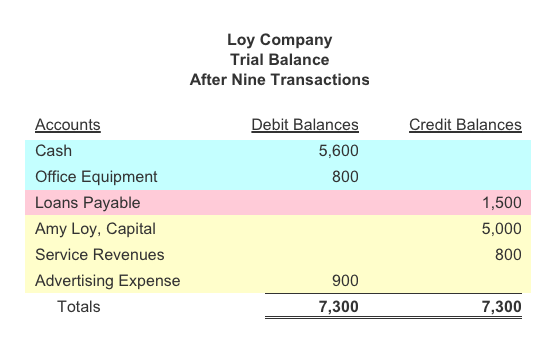
The totals in the accounting equation and the balance sheet after the ninth transaction are:

Recap of Debits and Credits
Debit means left.
Credit means right.
Assets are expected to have debit balances.
Liabilities are expected to have credit balances.
The owner’s equity capital account is expected to have a credit balance.
The stockholders’ equity accounts are expected to have credit balances.
When a company receives money, it debits Cash (and it must also credit another account, such as Accounts Receivable).
When a company writes a check, it credits Cash (and it must also debit another account, such as Accounts Payable).
Recap of Debits and Credits
Expenses should be debited (because expenses reduce owner’s equity) and another account must be credited.
Revenues should be credited (because revenues increase owner’s equity) and another account must be debited.
Under the accrual method of accounting, revenues are reported on the income statement in the period in which they are earned.
Under the accrual method of accounting, expenses are reported on the income statement in the period in which they are used up or match up with revenues.
The End
There are more resources to assist you under our topic Debits and Credits.
Turn on study mode to focus
Debits and Credits Outline
- Read our Explanation (4 Parts) Free
- Read our Additional Explanation (3 Parts) Free
- Take our Practice Quiz Free
- Review our Visual Tutorial
- Watch our Bookkeeping Video Training
- Review our Flashcards
- Solve our Word Scramble Free
- Solve our Crossword Puzzle #1 Free
- Solve our Crossword Puzzle #2 Free
- Solve our Crossword Puzzle #3 Free
- Review our Cheat Sheet
- Take our Quick Test #1
- Take our Quick Test #2
- Take our Quick Test #3
- Take our Quick Test #4 with Coaching
- Earn our Debits and Credits Certificate of Achievement
Learn How to Advance Your Accounting and Bookkeeping Career
- Perform better at your current job
- Refresh your skills to re-enter the workforce
- Pass your accounting class
- Understand your small business finances
Featured Review
"I can't believe how much more confidence AccountingCoach PRO has given me, and I never want to be without it! I received my degree in accounting, but still found that I had questions, and did not feel confident in my abilities to perform in my new position as an accountant in a small contract manufacturing company. Because of this, I purchased the PRO version so that I could study sections I was not clear about and then test my knowledge. Being able to keep track of what you have studied is great, but what I love most is that I am able to figure out what I need more help in with the tests, and then use the flashcards to help me understand those areas better—so much so that I have challenged decisions from our controller, and was able to intelligently discuss my reasoning and be granted permission for change. Any person wanting to become a bookkeeper or accountant would benefit from using AccountingCoach, but having the PRO version takes it to the next level! Oh, by the way—I started as the staff accountant, and have since been promoted to Assistant Controller and will be promoted again to Controller when our current controller retires in less than a year. Thank you!" - Anna W.




